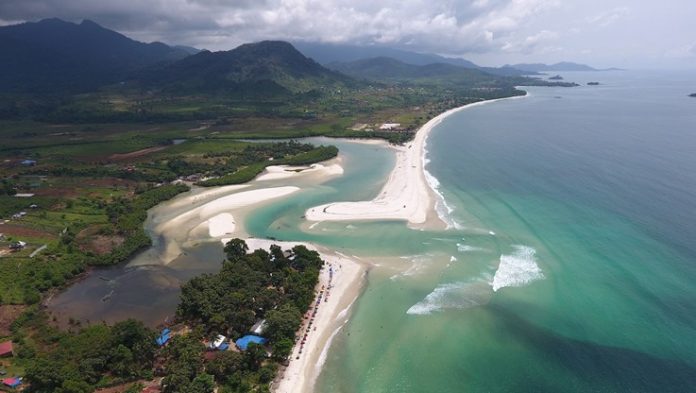However, this melting pot of colorful cultures with it buzzing capital, tropical rainforest, unforgettable wildlife and white-sand beaches definitely deserves its place in the glossy travel magazines.
The Sierra Leone National Tourist Board and Ministry of Tourism recently told the press at World Travel Market in London that the country wanted to change its narrative and improve its national image. The minister even mentioned the country has high hopes for tourism to become the lead industry.
In an age where travelers are increasingly looking for off-the-beaten-track, unknown and authentic experiences, Sierra Leone truly checks all the boxes. The country features long stretches of empty and uninterrupted beaches, unique cultural experiences and unforgettable wildlife.
The most beautiful beach in Africa can be found near Tokeh, according to Sierra Leone locals. Tokeh is a small coastal village on the Western Area Peninsula. Locals are always happy to invite travelers to join them on a fishing trip, show them how they smoke fish or invite them to have a drink in the Palmwine Bar. Tokeh is home to a large resort called “The Place,” and there are other accommodations available, as well.
Sierra Leone’s 250 miles of pristine Atlantic coastline is dotted with little “hidden” islands: Sherbro is the biggest, while the three Banana Islands lie just across from Freetown. Bunce Island, in Freetown’s massive natural harbor, is the most developed, and the Turtle Islands are the most unspoiled.
Sierra Leone’s islands show incredible potential when it comes to ecotourism. The previously forgotten Tasso Island, for example, lies at the heart of one of Africa’s most precious wetlands, the Sierra Leone River Estuary.
Tasso Island has its own camp, which is run by the Tasso Ecotourism Project, a community business that aims to bring new jobs and livelihoods to the 5,000 islanders who currently rely entirely on fishing. The camp features five wooden beachside chalets and a restaurant built around the trunk of a baobab tree. Tasso Island is a great base for local walks, and exploration of the estuary.
Meanwhile, the Tiwai Island Wildlife Sanctuary, in the central-south part of the country, reportedly offers the second-highest concentration of primates in the world. Rare and endangered species such as the Diana monkey and the pygmy hippopotamus can be found in the sanctuary.
Visitors to Tiwai Island can spend a few days hiking through beautiful natural settings, learning about the rich cultural and historical heritage of the Mende people. The Heritage Trail on the island is a community-created and -managed experience that will introduce visitors to the everyday life of the communities that surround the Tiwai Island Wildlife Sanctuary.
The Kambama village is usually the starting point for all Heritage Trails on Tiwai Island. In Kambama, there is a blacksmith who is essential to the working life of all villagers, an herbalist who is knowledgeable in herbal medicines, and an eco-campsite that was created and is now run by the town speaker, Chief Hindowa Kamara, and other community members.
The most remote community on the heritage trail, Segbewema can only be accessed by bush trails and has retained some of the mysterious qualities of Sierra Leone’s rural communities. Characterized by its small, tightly built thatch huts, this village is a window into times past. It is possible, on the heritage trail, to enjoy a homestay at Segbewema and experience how people live their daily lives.
The main ecotourism drawcard for Sierra Leone, however, remains the Tacugama Chimpanzee Sanctuary. It is famous for its rehabilitation efforts for domesticated chimps. The sanctuary opened in 1995, although the story started long before that. In 1988, the owners, Bala and Sharmila Amerasekaran, bought a sick chimpanzee on the street and nursed it back to health. This was a life-altering experience, as their fondness and knowledge of these animals grew. They later discovered the dangers that chimpanzees face in Sierra Leone and how they are treated in captivity, and over the years their hard work transpired into the creation of the sanctuary that stands today.
Today, most chimps that arrive at the sanctuary are less than five years old and would normally still be suckling milk from their mothers. Many are mistreated by their owners, injured, malnourished or disabled; they have been abandoned or illegally sold as pets.
Travelers can visit the sanctuary and see the chimps on a guided forest walk. But the sanctuary offers more than only site visits. Tacugama aims to be at the forefront of preserving Sierra Leone’s remaining wildlife through education, community support and ecotourism. Tacugama has become an eco-tourism hub with six ecolodges and a variety of activities for both tourists and locals. There are many routes around the beautiful surroundings of Tacugama offering hikers a range of day trails and paths to explore, peaks to summit and views to take in.
Sierra Leone won’t stay a secret for long. Advise your clients to visit this beautiful part of Africa before everyone discovers this beautiful country.






